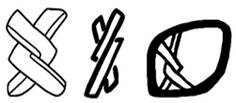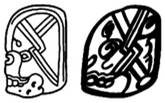![]()


K&L.p37.#2.2 TOK.p18.r5.c4 BMM9.p12.r1.c2 25EMC.pdfp37.#1.2 = K&L.p37.#2.2
JAL JAL JAL


MHD.ZQ8.1&2&3 0551st
JAL JAL




MHD.SCF.!&2 0551hc MHD (Montgomery) MHD archive
CNK Panel Fragment B1 PAL Region Stucco 8 glyph-block A
JAL JAL 13.<<[K’AN]JAL>:bu> 15.<<<[K’AN]JAL>.bu>:wa>
· No glyphs given in K&H.
· Variants (2):
o A. Simple – features:
§ Two “interwoven” strands, typically only one “crossing”, but three or more are also known.
§ (Optionally) each strand can have reinforcement along one edge.
§ Each strand may end before reaching the outer boundary of the glyph, or may touch the boundary and “disappear” into it.
o A. Skull:
§ The simple variant, infixed into a skull with nose hole and bone jaw.
§ The two examples are for the Haab-month K’anjalaw/Pop, found by a search in MHD on “blcodes contains SCF”.
· MHD statistics (2024-09-27):
o Simple variant: “blcodes contains ZQ8” yields 157 hits. Adding the clause “blsem does not contain 365” filters out the ones which are not JAL in a HAAB month-name and yields 8 hits, 3 of which are the name of a lord, Jal Ajaw (one on an unprovenienced vase K6436, one from DBZ (Dzibanche), and one from YUL (Yula)). The remaining 5 are personal names, names of objects, or indeterminate.
o Skull variant: “blcodes contains SCF” yields 4 hits of which the two examples above are obviously JAL in a HAAB month-name.
This shows that this glyph is used overwhelmingly to write the Haab month K’anjalaw/Pop rather than for its literal meaning of “weave”, “manifest”, or “appear” (though the month name itself also holds, of course, that meaning as a part of its name).
· Do not confuse this with the visually and phonetically similar JEL – they are semantically very different: JAL = “to weave”, “manifest”, or “appear” whereas JEL = “to replace, change, adorn”.
o Some sources do not distinguish JAL from JEL.
o For those which do, JAL consists of two strands actually “interwoven” whereas JEL consists of only two bars “crossing”.
· Do not confuse this with the homonym JAL/JALAL = “reed”.
· This logogram has a number of independent, unrelated meanings: “weave”, “manifest/appear”:
o EB.p82.pdfp87.#3 gives only “reed”.
o K&H.p91.#2 gives only “manifest”, and lists JALAL as meaning “reed” (no glyphs given for either JAL or JALAL).
o K&L.p37.#2 gives “weave” but says it’s used as a rebus to write “appear”, and lists JALAL as meaning “reed” with a separate, distinctly different (unrelated, more representational) glyph.
o BMM9.p90.#13 gives only “manifest” (with an example glyph). It lists JALAL as meaning “reed” (but without example glyphs).
o 25EMC.pdfp37.#1 gives both “manifest/appear” and “weave”, and lists JALAL as meaning “reed” with a separate, distinctly different (unrelated, more representational) glyph.
· In addition to the more literal meaning JAL = “to weave”, there is also the meaning “to manifest/appear”. As with the distinction BAAK = “bone” vs. BAAK = “captive”, it’s difficult to say whether these two “different” meanings might be two shades of the same basic etymon (from an emic point of view) or if, instead, they are just two independent etymons which happen to be homonyms (and for which the logogram for one was used as a rebus for writing the other).